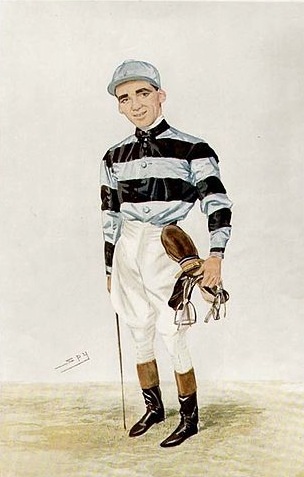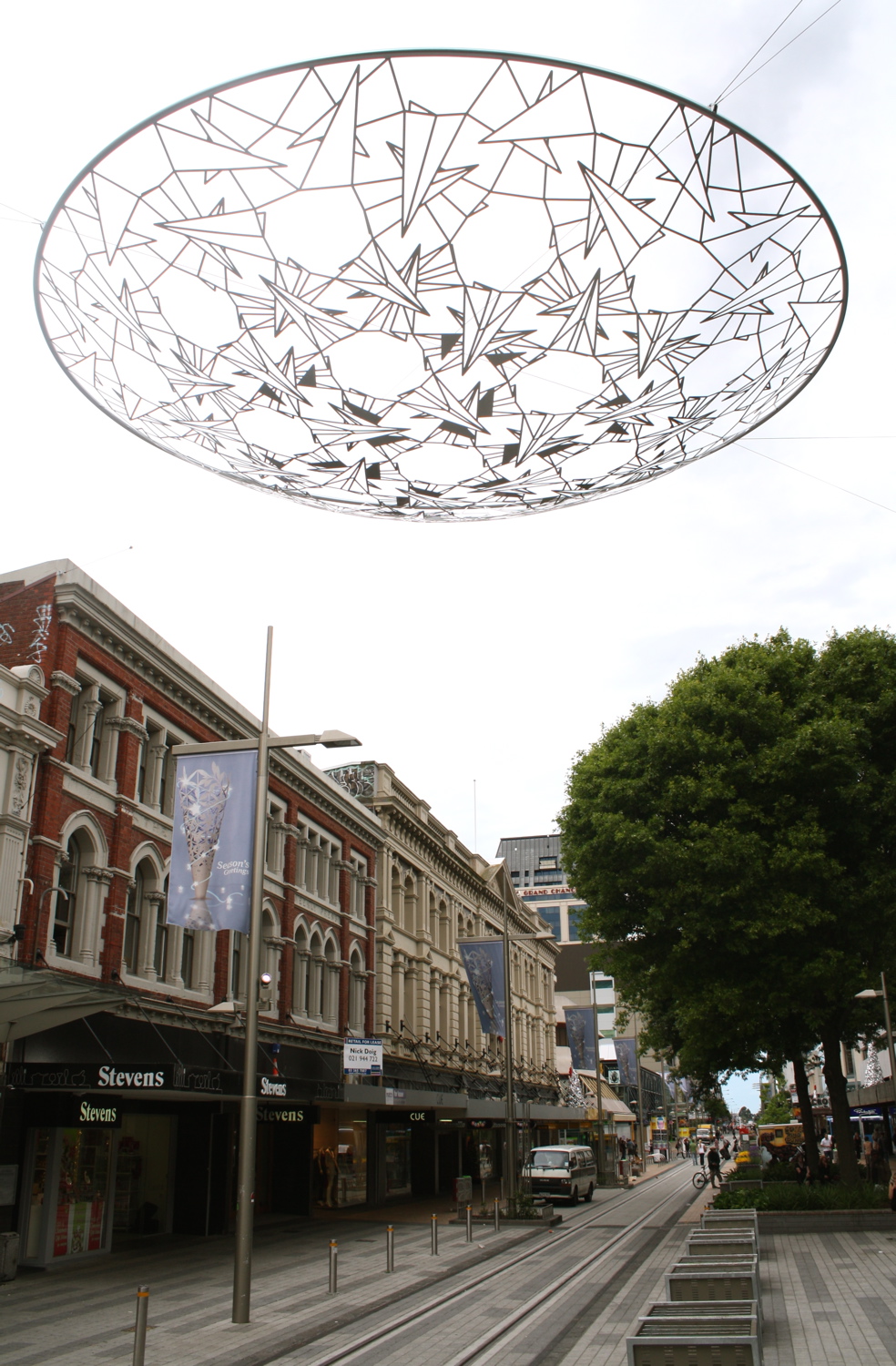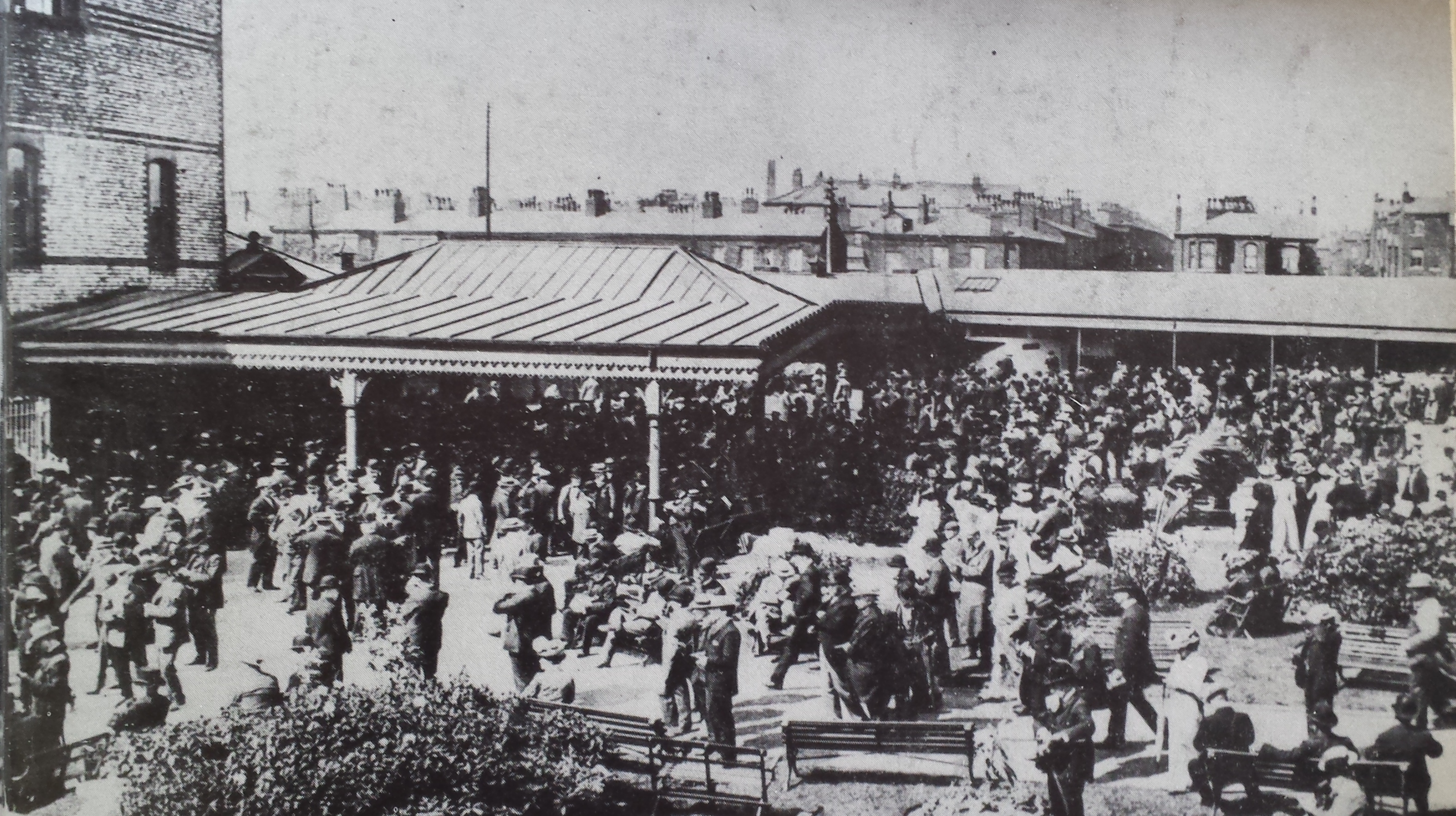|
Pogrom (horse)
Pogrom (1919 – 1933) was a British Thoroughbred racehorse and broodmare. As a two-year-old in 1921 she showed considerable promise by winning four of her six starts. In the following year she was one of the best fillies of her generation as she won the Epsom Oaks, Coronation Stakes and Newmarket Oaks and finished second on three other occasions. She made very little impact as a broodmare and died in 1933. Background Pogrom was a bay mare bred in the United Kingdom by her owner Waldorf Astor, 2nd Viscount Astor. She was sent into training with Alec Taylor, Jr. at his stable at Manton, Wiltshire. She was one of the best horses sired by Lemberg, whose wins included the Epsom Derby, Eclipse Stakes and Champion Stakes. Pogrom's performances helped Lemberg to become Britain’s Champion sire in 1922. Her dam Popingaol won two minor races but became a very successful broodmare whose other foals included Book Law (St Leger), Splendid Jay (Yorkshire Oaks), Book Debt (dam of Pay Up ... [...More Info...] [...Related Items...] OR: [Wikipedia] [Google] [Baidu] |
Lemberg (horse)
Lemberg (1907–1928) was a British Thoroughbred racehorse and sire. He won seventeen times in a career that lasted from 1909 until 1911, taking major races at two, three and four years of age. Lemberg won his most important victory as a three-year-old in 1910 when he won The Derby. His career was marked by his rivalries, first with the fast and precocious Neil Gow and later with the outstanding middle-distance runner Swynford. Lemberg went on to have a successful career at stud. Background Lemberg was bred by his owner Alfred W. Cox who raced his horses under the name of "Mr. Fairie". He was sired by Cyllene, an Ascot Gold Cup winner, who went on to become a highly successful stallion. In addition to Lemberg, he sired three other winners of The Derby and through his grandson, Phalaris, he is the direct male-line ancestor of most modern thoroughbreds. Lemberg's dam, Galicia was an outstanding broodmare. In the year before Lemberg's birth she produced Bayardo, the best Br ... [...More Info...] [...Related Items...] OR: [Wikipedia] [Google] [Baidu] |
Yorkshire Oaks
The Yorkshire Oaks is a Group 1 flat horse race in Great Britain open to fillies and mares aged three years or older. It is run at York over a distance of 1 mile 3 furlongs and 188 yards (2,385 metres), and it is scheduled to take place each year in August. History The event was established in 1849, and it was originally restricted to fillies aged three. The inaugural running was won by Ellen Middleton, owned by the 2nd Earl of Zetland. The present system of race grading was introduced in 1971, and the Yorkshire Oaks was subsequently classed at Group 1 level. It was opened to older fillies and mares in 1991. The race has been sponsored by Darley Stud since 2006, and it is currently held on the second day of York's four-day Ebor Festival meeting. The Yorkshire Oaks often features horses which ran previously in The Oaks. The first to achieve victory in both races was Brown Duchess in 1861, and the m ... [...More Info...] [...Related Items...] OR: [Wikipedia] [Google] [Baidu] |
1000 Guineas
The 1000 Guineas Stakes is a Group 1 flat horse race in Great Britain open to three-year-old fillies. It is run on the Rowley Mile at Newmarket over a distance of 1 mile (1,609 metres), and it is scheduled to take place each year in late April or early May on the Sunday following the 2000 Guineas Stakes. It is the second of Britain's five Classic races, and the first of two restricted to fillies. It can also serve as the opening leg of the Fillies' Triple Crown, followed by the Oaks and the St Leger, but the feat of winning all three is rarely attempted. History The 1000 Guineas was first run on 28 April 1814, five years after the inaugural running of the equivalent race for both colts and fillies, the 2000 Guineas. The two races were established by the Jockey Club under the direction of Sir Charles Bunbury, who had earlier co-founded the Derby. They were named according to their original prize funds ... [...More Info...] [...Related Items...] OR: [Wikipedia] [Google] [Baidu] |
Fractional Odds
Odds provide a measure of the likelihood of a particular outcome. They are calculated as the ratio of the number of events that produce that outcome to the number that do not. Odds are commonly used in gambling and statistics. Odds also have a simple relation with probability: the odds of an outcome are the ratio of the probability that the outcome occurs to the probability that the outcome does not occur. In mathematical terms, where p is the probability of the outcome: :\text = \frac where 1-p is the probability that the outcome does not occur. Odds can be demonstrated by examining rolling a six-sided die. The odds of rolling a 6 is 1:5. This is because there is 1 event (rolling a 6) that produces the specified outcome of "rolling a 6", and 5 events that do not (rolling a 1,2,3,4 or 5). The odds of rolling either a 5 or 6 is 2:4. This is because there are 2 events (rolling a 5 or 6) that produce the specified outcome of "rolling either a 5 or 6", and 4 events that do n ... [...More Info...] [...Related Items...] OR: [Wikipedia] [Google] [Baidu] |
Epsom Racecourse
Epsom Downs is a Grade 1 racecourse on the hills associated with Epsom in Surrey, England which is used for thoroughbred horse racing. The "Downs" referred to in the name are part of the North Downs. The course, which has a crowd capacity of 130,000 when taking into account people watching from the Epsom Downs, an area freely available to the public, is best known for hosting the Derby Stakes, which has come to be widely referred to as The Derby or as the Cazoo Derby for sponsorship reasons, the United Kingdom's premier thoroughbred horse race for three-year-old colts and fillies, over a mile and a half (2400 m). It also hosts the Oaks Stakes (also widely referred to as The Oaks) for three-year-old fillies, and the Coronation Cup for horses aged four years and upwards. All three races are Group 1 races and run over the same course and distance. The Chairman of the course since 2015 is Julia Budd. The course is owned by the Jockey Club. The Queen has attended the Derby most y ... [...More Info...] [...Related Items...] OR: [Wikipedia] [Google] [Baidu] |
Truth (Brisbane Newspaper)
The ''Brisbane Truth'' newspaper was a subsidiary of Sydney ''Truth'', and was launched in 1890. Digitisation The paper has been digitised as part of the Australian Newspapers Digitisation Program of the National Library of Australia. References External links * {{trove newspaper, 942, Truth, Brisbane, Qld. : 1900 - 1954 Truth Truth is the property of being in accord with fact or reality.Merriam-Webster's Online Dictionarytruth 2005 In everyday language, truth is typically ascribed to things that aim to represent reality or otherwise correspond to it, such as beliefs ... Truth (Newspaper) 1890 establishments in Australia Newspapers established in 1890 Newspapers on Trove Defunct newspapers published in Queensland 1954 disestablishments in Australia Publications disestablished in 1954 ... [...More Info...] [...Related Items...] OR: [Wikipedia] [Google] [Baidu] |
Lingfield Oaks Trial
The Oaks Trial Stakes is a Listed flat horse race in Great Britain open to three-year-old fillies. It is run over a distance of 1 mile, 3 furlongs and 133 yards () at Lingfield Park in May. History The event serves as a trial for the Epsom Oaks. Prior to World War II, it was called the Oaks Trial Plate. It became the Oaks Trial Stakes after the war. The left-handed track at Lingfield Park is similar to that at Epsom. It has an undulating, cambered terrain with a sharp downhill turn into the home straight. The Oaks Trial Stakes was formerly contested over 1 mile and 4 furlongs. It held Group 3 status from 1971 to 1985, and was relegated to Listed level in 1986. It was cut to its present distance in 1990. Several contenders have subsequently won the Oaks. The most recent was Anapurna, the winner in 2019. Records Leading jockey since 1960 (6 wins): * Pat Eddery – ''Suni (1978), Out of Shot ... [...More Info...] [...Related Items...] OR: [Wikipedia] [Google] [Baidu] |
The Press
''The Press'' is a daily newspaper published in Christchurch, New Zealand owned by media business Stuff Ltd. First published in 1861, the newspaper is the largest circulating daily in the South Island and publishes Monday to Saturday. One community newspaper—''Northern Outlook''- is also published by ''The Press'' and is free. The newspaper has won the title of New Zealand Newspaper of the Year (in its circulation category) three times: in 2006, 2007 and 2012. It has also won the overall Newspaper of the Year title twice: in 2006 and 2007. History James FitzGerald came to Lyttelton on the ''Charlotte Jane'' in December 1850, and was from January 1851 the first editor of the ''Lyttelton Times'', Canterbury's first newspaper. From 1853, he focussed on politics and withdrew from the ''Lyttelton Times''. After several years in England, he returned to Canterbury concerned about the proposed capital works programme of the provincial government, with his chief concern the pro ... [...More Info...] [...Related Items...] OR: [Wikipedia] [Google] [Baidu] |
Sandown Park
Sandown Park is a horse racing course and leisure venue in Esher, Surrey, England, located in the outer suburbs of London. It hosts 5 Grade One National Hunt races and one Group 1 flat race, the Eclipse Stakes. It regularly has horse racing during afternoons, evenings and on weekends, and also hosts many non racing events such as trade shows, wedding fairs, toy fairs, car shows and auctions, property shows, concerts, and even some private events. It was requisitioned by the War Department from 1940-1945 for World War II. The venue has hosted bands such as UB40, Madness, Girls Aloud, Spandau Ballet and Simply Red. The racecourse is close to Esher railway station served by trains from London Waterloo. There is a secondary exit from Esher station which is open on race days, this exit leads directly into the racecourse and Lower Green, Esher. History Sandown Park was one of the first courses to charge all for attending. It opened in 1875 and everyone had to pay at least half a ... [...More Info...] [...Related Items...] OR: [Wikipedia] [Google] [Baidu] |
Newmarket Racecourse
Newmarket Racecourse is a British Thoroughbred horse racing venue in Newmarket, Suffolk, Newmarket, Suffolk, comprising two individual racecourses: the Rowley Mile and the July Course. Newmarket is often referred to as the headquarters of Horse racing in the United Kingdom, British horseracing and is home to the largest cluster of training yards in the country and many key horse racing organisations, including Tattersalls, the National Horseracing Museum and the National Stud. Newmarket hosts two of the country's five British Classic Races, Classic Races – the 1,000 Guineas and 2,000 Guineas, and numerous other Group races. In total, it hosts 9 of British racing's List of British flat horse races#Group 1, 36 annual Group One, Group 1 races. History Racing in Newmarket was recorded in the time of James VI and I, James I. The racecourse itself was founded in 1636. Around 1665, Charles II of England, Charles II inaugurated the Newmarket Town Plate and in 1671 became the fi ... [...More Info...] [...Related Items...] OR: [Wikipedia] [Google] [Baidu] |
Manchester Racecourse
Manchester Racecourse was a venue for horse racing located at a number of sites around the Manchester area including; Kersal Moor, New Barnes, Weaste and Castle Irwell, Pendleton, then in Lancashire. The final home of the course, Castle Irwell, was closed in 1963. Despite its name, the course was never actually located within the boundaries of the ancient township of Manchester or the subsequent city of Manchester. Location and history The earliest known horse races in the Manchester area were run at Barlow Moor, first recorded in 1647, and again from 1697 to 1701 and the earliest record of horse-racing on Kersal Moor is from a notice in the '' London Gazette'' of 2–5 May 1687.Farrer, William and Brownbill, J. (editors) (1911). 'Townships: Broughton', ''A History of the County of Lancaster'': Volume 4, pp. 217–222. URL: http://www.british-history.ac.uk/report.aspx?compid=41408. Date accessed: 20 February 2008 There were a number of other short-lived courses or on ... [...More Info...] [...Related Items...] OR: [Wikipedia] [Google] [Baidu] |
Lewes
Lewes () is the county town of East Sussex, England. It is the police and judicial centre for all of Sussex and is home to Sussex Police, East Sussex Fire & Rescue Service, Lewes Crown Court and HMP Lewes. The civil parish is the centre of the Lewes local government district and the seat of East Sussex County Council at East Sussex County Hall. A traditional market town and centre of communications, in 1264 it was the site of the Battle of Lewes. The town's landmarks include Lewes Castle, Lewes Priory, Bull House (the former home of Thomas Paine), Southover Grange and public gardens, and a 16th-century timber-framed Wealden hall house known as Anne of Cleves House. Other notable features of the area include the Glyndebourne festival, the Lewes Bonfire celebrations and the Lewes Pound. Etymology The place-name 'Lewes' is first attested in an Anglo-Saxon charter circa 961 AD, where it appears as ''Læwe''. It appears as ''Lewes'' in the Domesday Book of 1086. The additio ... [...More Info...] [...Related Items...] OR: [Wikipedia] [Google] [Baidu] |




